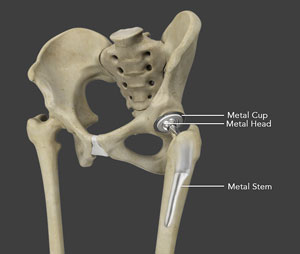Dr. Makda provided EXCEPTIONAL care to my father for his knee replacements.
Dr. Makda provided EXCEPTIONAL care to my father for his knee replacements. His attention to his patients and willingness to explain the treatment pla...

Arthritis is inflammation of the joints resulting in pain, swelling, stiffness and limited movement. Hip arthritis is a common cause of chronic hip pain and disability.
The three most common types of arthritis that affect the hip are:
The most common symptom of hip arthritis is joint pain and stiffness resulting in limited range of motion. Vigorous activity can increase the pain and stiffness which may cause limping while walking.
Diagnosis is made by evaluating medical history, a physical examination and X-rays.
Total hip replacement is a surgical procedure in which the damaged cartilage and bone is removed from the hip joint and replaced with artificial components. The hip joint is one of the body's largest weight-bearing joints, located between the thighbone (femur) and the pelvis (acetabulum). It is a ball and socket joint in which the head of the femur is the ball and the pelvic acetabulum forms the socket. The joint surface is covered by a smooth articular cartilage which acts as a cushion and enables smooth movements of the joint.
Several diseases and conditions can cause damage to the articular cartilage. Total hip replacement surgery is an option to relieve severe arthritis pain that limits your daily activities.
Surgery may be recommended, if conservative treatment options such as anti-inflammatory medications and physical therapy do not relieve the symptoms.
The surgery is performed under general anesthesia. During the procedure, a surgical cut is made over the hip to expose the hip joint and the femur is dislocated from the acetabulum. The surface of the socket is cleaned and the damaged or arthritic bone is removed using a reamer. The acetabular component is inserted into the socket using screws or occasionally bone cement. A liner made of plastic, ceramic or metal is placed inside the acetabular component. The femur or thighbone is then prepared by removing the arthritic bone using special instruments, to exactly fit the new metal femoral component. The femoral component is then inserted to the femur either by a press fit or using bone cement. Then the femoral head component made of metal or ceramic is placed on the femoral stem. All the new parts are secured in place using special cement. The muscles and tendons around the new joint are repaired and the incision is closed.
After undergoing total hip replacement, you must take special care to prevent the new joint from dislocating and to ensure proper healing. Some of the common precautions to be taken include:
As with any major surgical procedure, there are certain potential risks and complications involved with total hip replacement surgery. The possible complications after total hip replacement include:
Dr. Makda provided EXCEPTIONAL care to my father for his knee replacements.
Dr. Makda provided EXCEPTIONAL care to my father for his knee replacements. His attention to his patients and willingness to explain the treatment pla...
I had needed knee replacements for quite awhile.
I had needed knee replacements for quite awhile. I even saw other doctors about it but never moved forward as I realized now it all was never explaine...
Dr. Makda is wonderful. He is kind, very knowledgeable and offers different types of recovery for knee problems. After 3 visits I was released from ca...
My left knee was replaced in the hands of Dr Makda last July
My left knee was replaced in the hands of Dr Makda last July. Now my right hip in 2 weeks (mid April 2019).
All went as expected. Have to do all the therapy if you want to recover fast.
All went as expected. Have to do all the therapy if you want to recover fast. Very happy with my new left knee.
100 Village Green Drive
Suite 120
Lincolnshire, IL 60069